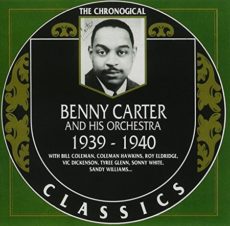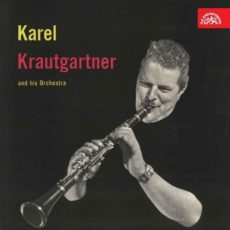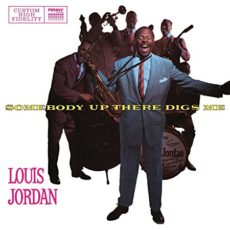
Daily Dose Of Jazz…
Fletcher Allen was born on July 25, 1905 in Cleveland, Ohio and began his career in the mid-’20s as a member of Lloyd Scott’s Band in New York City. In 1927, he was off to Europe for the first time in a group under the direction of Leon Abbey, a bandleader whose pioneering efforts with jazz eventually led to a 1936 tour of India which he also participated in. In between, he went to Budapest with the Benny Peyton group in 1929 and hung out in Europe the following decade. While in Europe he performed on several collaborations with guitarist Django Reinhardt, among others.
Reinhardt recorded some of his arrangements and compositions, including the intoxicating Viper’s Dream. Allen also took advantage of the European base to take part in several tours involving top American performers such as Louis Armstrong, Freddy Taylor and Leon Abbey in the ’30s. It was during this time that he began leading his own band.
By 1938, he began performing with Benny Carter, something of a doppelgänger in that both men played alto saxophone and clarinet and had excellent reputations as arrangers and shows up several times in the extensive Carter discography. He went on to Later that year, Allen went to Egypt as a member of the Harlem Rhythmakers group during an era when American jazz musicians held court at swank Cairo hotels, a situation that would be quite inconceivable in modern times.
As World War II escalated Fletcher returned home to the States and at first found little work but eventually left the docks when he found that his new skills on baritone sax meant work filling in the sections of various New York big bands. His last job of any notoriety began in the early 70s with the big band of Fred “Taxi” Mitchell, meaning he was one New Yorker who always managed to find a taxi.
Saxophonist, clarinetist and composer Fletcher Allen, whose composition Viper’s Dream has become a jazz staple, passed away on August 5, 1995.
Sponsored By

![]()
#preserving genius

Daily Dose Of Jazz…
Karel Krautgartner was born on July 20, 1922 in Mikulov, Moravia and began to play piano at the age of eight. In 1935, after moving to Brno, he found interest mainly in the radio broadcasting and especially in jazz. He began to study clarinet privately with Stanislav Krtička, acquiring necessary skills and inherited a fanatic passion for clarinet construction and its components.
In 1936 Krautgartner founded the student orchestra Quick Band and six years later signed his first professional contract as a saxophonist in the Gustav Brom Orchestra in the hotel Passage in Brno. In 1943 he gradually created Dixie Club and started to arrange in the Benny Goodman and Glenn Miller styles. During 1945 – 1955, the core of the Dixie Club moved gradually to Prague and became a part of Karel Vlach orchestra. Karel became leader of the saxophone section and started to contributing his own compositions.
1956 saw him founding the Karel Krautgartner Quintet along with Karel Velebný. The group played in various line-ups modern jazz, swing, dixieland and accompanied popular singers. From 1958 to 1960 he performed with the All star band, an orchestra playing in west-coast style, and dixieland with Studio 5. Between 1960 and 1968 he became the head of the Taneční Orchestr Československého Rozhlasu (Dance Orchestra of Czechoslovakia Radio), renamed to Karel Krautgartner Orchestra in 1967.
Following the Soviet invasion of Czechoslovakia, he emigrated to Vienna, Austria in 1968 and became the chief conductor of the 0RF Bigband. Later he moved to Cologne, Germany. Clarinetist, saxophonist, arranger, composer, conductor and teacher Karel Krautgartner passed away on September 20, 1982 in Germany.
#preserving genius

Daily Dose Of Jazz…
Chico Freeman was born Earl Lavon Freeman Jr. on July 17, 1949 in Chicago, Illinois to saxophonist Von Freeman. His initial outing on his musical path came from his brother Everett who introduced him to the trumpet and began playing, inspired by Miles Davis. In 1967 he attended Northwestern University on scholarship for mathematics and played the trumpet in the school, but did not begin playing the saxophone until his junior year.
Changing his major to music, he graduated in 1972, proficient playing saxophone, trumpet, and piano. After graduation, Freeman taught at the Association for the Advancement of Creative Musicians School of Music in Chicago and started taking classes as a graduate student at Governors State University, earning a master’s degree in composition and theory. Though focused on jazz during this period he also played blues in local clubs with Memphis Slim and Lucky Carmichael.
1976 saw the release of his debut album as a leader, Morning Prayer and moving to New York City the next year he widened his musical influences. He would experience his most productive years of his career, releasing albums such as No Time Left, Tradition in Transition and The Outside Within which earned him Record of the Year from Stereo Review. Coming to prominence in the late 1970s Chico was part of a movement including Wynton Marsalis of modern players steeped in the traditions of jazz.
He went on to record for independent labels India Navigation and Contemporary Records enlisting the talents of Wynton Marsalis, Bobby Hutcherson and Cecil McBee. He formed the band Guataca with Hilton Ruiz, Ruben Rodriguez, Yoron Israel and Giovanni Hidalgo and released Oh By the Way… in 2002. Freeman has toured internationally, both with his band as well as with Chaka Khan, Tomasz Stanko, Celia Cruz and Tito Puente.
His electric band Brainstorm brought together Delmar Brown on vocals and keyboards, percussionist Norman Hedman, bassist Chris Walker, and Archie Walker on drums. By the end of the Nineties he was producing Arthur Blythe’s album NightSong and beginning his teaching role at New School University.
Tenor saxophonist, bass clarinetist and trumpeter Chico Freeman, who was a recipient of the New York Jazz Award, continues to compose, perform and educate.


Daily Dose Of Jazz…
Louis Thomas Jordan was born on July 8, 1908 in Brinkley, Arkansas where his father was a music teacher and bandleader for the Brinkley Brass Band and the Rabbit Foot Minstrels. Losing his mother young, he studied music under his father, starting out on the clarinet, then piano and ultimately landed on the saxophone as his primary instrument. In his youth he played in his father’s bands instead of doing farm work when school closed. During his early career period he played the piano professionally, but alto saxophone became his main instrument. However, he would become even better known as a songwriter, entertainer and vocalist.
He briefly attended and majored in music at Arkansas Baptist College in Little Rock, but after a period with the Rabbit Foot Minstrels and with other local bands like Bob Alexander’s Harmony Kings, he went to Philadelphia and then New York. By 1932, Jordan was performing with the Clarence Williams band, and when he was in Philadelphia he played clarinet in the Charlie Gaines band.
1936 saw him joining the Savoy Ballroom orchestra, led by the drummer Chick Webb. A vital stepping-stone in his career, Louis introduced songs as he began singing lead, and often singing duets with up and comer Ella Fitzgerald. They would later reprise their partnership on several records, by which time both were major stars. In 1938, Webb fired Jordan for trying to persuade Fitzgerald and others to join his new band.
He became famous as one of the leading practitioners, innovators and popularizers of jump blues, a swinging, up-tempo, dance-oriented hybrid of jazz, blues and boogie-woogie. Jordan’s band also pioneered the use of the electronic organ.
Jordan was a talented singer with great comedic flair, and he fronted his own band for more than twenty years. He duetted with some of the biggest solo singing stars of his time, including Bing Crosby, Ella Fitzgerald and Louis Armstrong. An actor and a major black film personality, he appeared in dozens of “soundies” or promotional film clips, made numerous cameos in mainstream features and short films, and starred in two musical feature films made especially for him.
With his dynamic Tympany Five bands, Jordan mapped out the main parameters of the classic R&B, urban blues and early rock-and-roll genres with a series of highly influential 78-rpm discs released by Decca Records. These recordings presaged many of the styles of black popular music of the late 1940s, 1950s and 1960s and exerted a strong influence on many leading performers in these genres.
Known as The King of the Jukebox for his crossover popularity with both black and white audiences of the swing era, Louis was a prolific songwriter who wrote or co-wrote many songs that stayed in the top of the Billboard charts and that were influential classics of 20th-century popular music.
Pioneering alto saxophonist, pianist, clarinetist, singer, actor, songwriter and bandleader Louis Jordan, one of the most successful black recording artists of the 20th century, passed away on February 4, 1975 at age 66 in Los Angeles, California.
#preserving genius

Daily Dose Of Jazz…
Bill Trujillo was born on July 7, 1930 in Los Angeles, California and started clarinet lessons at the age of four, then switched to tenor saxophone after seeing Lester Young perform with Count Basie in Los Angeles. His mother, a dance teacher at the famous Palomar Ballroom, regularly took him and his older brother to hear big bands when they were in residence at the Palomar, the Paramount, and other popular LA show places.
Learning to read music before he could read words and after Lincoln High School, where his friend and classmate was Lennie Niehaus played, Trujillo started his long professional career at the age of 16 with the West Coast based Glenn Henry Band. The band also boasted a young trombone player named Jimmy Knepper. During the ’40s, Bill played with Alvino Rey and other West Coast groups. In 1953, he joined Woody Herman with whom he remained until the following year when Bill Russo beckoned he joined the quintet but then playing in Chicago. Eventually finding the Windy City too cold, he returned to L.A. where he played in the orchestras of Charlie Barnet and Jerry Gray, and gigged with small groups.
At the behest of his longtime friend Lennie Niehaus, Trujillo joined Stan Kenton band in 1958, however, road trips often lasting a year or more put too much of a strain on his young family. Moving to Las Vegas, Nevada in 1960 he played with Nat Brandywynne and he has been there ever since. He became a mainstay in show orchestras at the Tropicana, Flamingo, Thunderbird and the Dunes playing behind Frank Sinatra, Ella Fitzgerald, Peggy Lee and many other. After a labor dispute in 1989 dried up this source of work, he returned to playing in big bands and small groups throughout the country.
In 1999 he led his debut album It’s Tru followed by his 2006 It’s Still Tru with Carl Fontana on the TNC label. As an educator, saxophonist Bill Trujillo teaches clarinet, flute, and all saxophones while continuing to perform in Las Vegas.
#preserving genius



